Adverbial PhraseAdverbial phrases are phrases that are formed around an Adverb. In other terms, it's a multi-word phrase that acts as an adverb, altering the verbs, adjectives, or other adverbs. 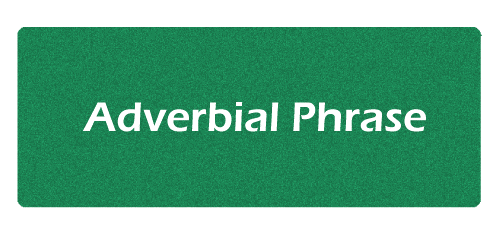
So, Adverbial phrases are sentences or groups of words that have the same underlying meaning as the adverbs. As a result, adverbial phrases are frequently employed to substitute adverbs. Learning when to utilize each type of adverbial unit is critical, as there are several ways they can help you enhance your language skills. What Exactly Is an Adverb?An adverb is a type of word that is employed to change the words around it. Silently, cheerfully, promptly, and truly are some examples. Adverbs generally express how, when, or what happened at any given time. As a result, they tend to answer the questions or queries like who, what, where, and why. Adverbs will help your English become more rich and intriguing by using them in your speaking and writing. Adverbs are essential for engagingly conveying significant information. What Exactly Is an Adverbial Phrase?Adverbial phrases are groups of words that have the same meaning as adverbs. Adverbial phrases can change the meaning of a verb, adjectives, adverbs, clauses, or full sentences. Adverbial phrases add interest and excitement to a statement. They explain how (method), when (timing), where (location), why (reason), and how long (this is another kind of adverbial phrase of time). This additional information provides the reader with more depth, allowing them to acquire more understanding and clarity about what is unfolding in a text. Adverbial phrases are distinguished from adverbial clauses and single-word adverbs. Besides an adverbial clause, an adverbial phrase lacks a subject and verbs. Consider the sentences below :
The first sentence contains no adverbs or adverb phrases. The adverb "here" is used in the second phrase to define where the bike was stopped. The adverb phrase "right here" appears in the third sentence, emphasizing where the bike was stopped and employing a phrase rather than a single word. The group's final sentence features a lengthier, more explanatory adverbial phrase. Take note of the phrase "right here underneath the overpass." The prepositional phrase in this example serves as an adverb in the statement. It is a prepositional phrase that combines the preposition "underneath" with the object "overpass." It is both a prepositional phrase and an adverbial phrase because it alters the verb to describe the place. What Is the Distinction Between an Adverb and an Adverbial Phrase?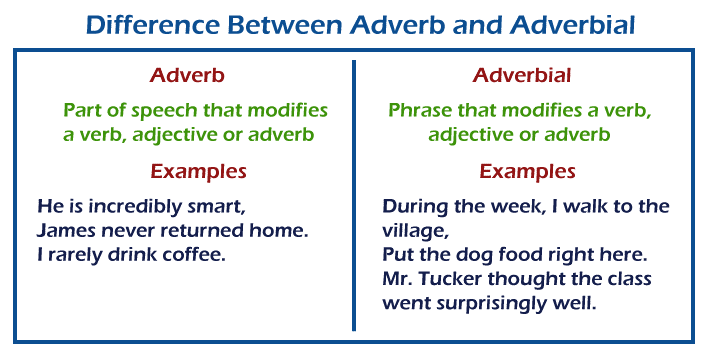
Adverbial phrases can be used as a substitute for the above single-word adverbs. As an example: Steven will come later vs. Steven will come in the evening The first sentence contains a standard adverb: 'later.' In this instance, we can tell that 'later' is an adverb since it tells us when steven will come. Similarly, in the second sentence, our adverbial phrase is 'in the evening.' The adverbial phrase serves the same purpose as a single adverb (providing us more context about the time, location, or manner of the occurrence) but with a set of words. What Are Some Adverbial Phrase Instances?An adverbial phrase must consist of two or more words, at least one of which is an adverb. Adverbial expressions that we may encounter frequently include:
For example
If they were omitted from each statement, the statements would be a lot simpler and provide less detail We wouldn't know why she didn't perform the horse riding without the adverbial word. So, if you've ever wondered, 'What is an adverbial phrase?' now you know. As you can see, adverbial phrases aid understanding by offering additional information. How to use Adverbial Phrases in A SentenceHere are a few examples of how adverbial phrases can be used in a sentence ;
What Is the Difference Between Adverbial Phrases And Adverbial Clauses?A subject and a verb are not required in an adverbial phrase. It only needs to be more than one word long and perform as an adverb, altering the verbs, adjectives, or another adverb. Adverbial clauses, on the other hand, must include a subject, a verb, and an adverb. 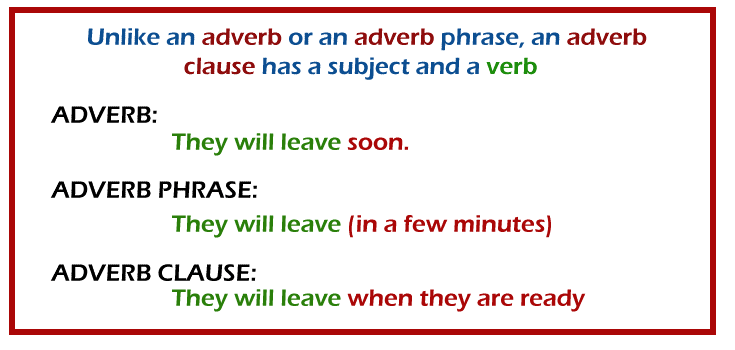
As an instance, consider the following : 'Before she eats her lunch' is an adverbial clause in this statement It's important to remember that adverbial clauses are always dependent clauses, often called as subordinate clauses. They can't stand on their own; in other terms, they don't make good sense without the remaining statement. Adverbial clauses change the main clause of a sentence ('She finishes her schoolwork,' for example). They provide additional information about what is happening in the main sentence. When Is an Adverbial Phrase a Fronted Adverbial?The adverbs, adverbial phrases, or the adverbial clauses that are employed at the start of a sentence are known as the fronted adverbial. Fronted adverbials, like conventional adverbial phrases, add richness and character to a sentence by informing us about when, where, how, or why something is performed or has occurred. Some of the above instances are fronted adverbials, such as : In a moment, I believe I'll have a piece of chocolate cake Most days, kids have to get up at 8 am The wonderful thing about adverbial phrases and clause is that we may often employ them at the start or conclusion of a sentence. We can, for example, utilize our adverbial clauses as the fronted adverbials. Wish to know-how? Before she eats her dinner, she finishes her homework This capacity allows us to vary our writings, making them more fascinating to the audience. However, a fronted adverbial is not always an adverbial phrase or clause. A singular adverb can function as a fronted adverbial on its own. As an example: Later, we will go to the museum Suddenly, the fog faded away Punctuation In Adverbial PhraseThe purpose of adverbial phrases and clauses is to make a statement more understandable. This will not happen if you do not use proper punctuation. Fortunately, getting it correctly is simple! The basic rule is that no comma is required if you use your adverbial phrase towards the end of sentences. In the line 'We will take the pet for a stroll in the afternoon,' there is no need for a comma in the mentioned sentence. If we utilize the adverbial phrase as the fronted adverbial, the statement becomes "In the afternoon, we will take the pet for a stroll." As we can see, this statement has a comma since it requires one. So, the basic rule is that you require a comma after an adverbial phrase at the start of a sentence, but you don't require one before an adverbial phrase at the end of sentences. Adverb Phrases Explain How, Where, Why, and WhenA simple adverb phrase normally consists of the adverbs and at least one other term before or after it. However, a prepositional or infinitive phrase can also function as an adverbial. When (Adverbial Phrase of Time)An adverbial phrase of timing specifies when or how frequently something occurs. For instance:
Where (Adverbial Phrase of Place)An adverbial phrase of location describes the location of an event For instance:
How (Adverbial Phrase of Manner)A method adverbial phrase describes how something is done For instance:
Why (Adverbial Phrase of Reason)A reasoning adverbial phrase explains why something is accomplished. For example:
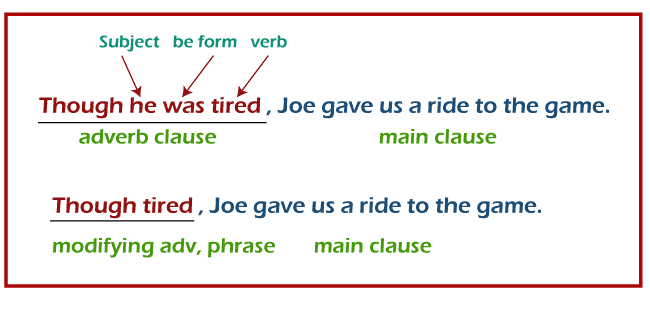
Adverbial Phrase StructureHere are three popular adverbial phrase formats:
Of course, there are alternative formats. As an example :
If you have a string of words that operate as an adverb but do not include the subject and the verb (" which means it is not an adverbial sentence), you have an adverbial phrase. 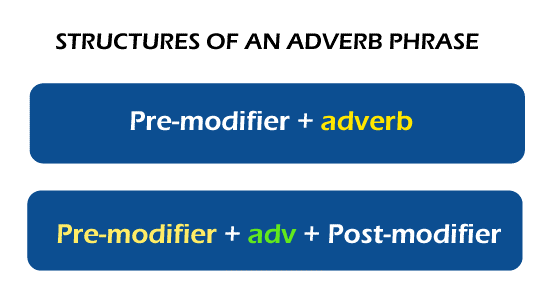
Why Are Adverbial Phrases Significant?Here are four compelling reasons to pay closer attention to adverbial phrases. (Reason 1) Take care not to construct an incorrectly placed modifier.A misaligned modifier is a term (or collection of words) that does not clearly link to the thing it is meant to alter. A misplaced modifier ambiguously or incorrectly alters the meaning of a statement. Consider the following example : John, coax the donkey with the piece of fruit (The underlined text is an incorrectly placed modifier.) It's an adverbial phrase that modifies the verb "coax." It is designed to instruct John on how to entice the donkey. On the other hand, the underlined text may be an adjective phrase characterizing the monkey, advising Jack on which donkey to coax.) John, use the piece of fruit to coax the donkey.- Correct Here's another example to give more clarity. This is a movie scene "He was a champion at his last fight. He once fired a thief with a Glock pistol. " (The underlined text is an incorrectly placed modifier.) It is intended to be an adjective phrase that describes the thief. It was, however, interpreted as an adverbial phrase altering the verb "fired." (Reason 2) Remove your intensifier unless absolutely necessary.The amount of intensity must be attained by word choice while writing formally (e.g., by employing strong adjectives rather than intensifiers). The use of intensifiers is usually regarded as lazy writing. She was very furious (This is known as sloppy writing. ) She was outraged (With a powerful adjective like "outraged," there is no requirement for an intensifier.) This quotation exemplifies why intensifiers should be used selectively "If everything is very essential, then nothing is essential. " Reason 3 - When writing adverbial clauses, utilize commas appropriately.A "fronted adverbial" is an adverbial phrase (or clause) that appears at the beginning of a sentence. A comma frequently follows a fronted adverbial. As an example: At 2 o'clock, close the doors Whenever the adverbial phrase is at the finish, it's common to leave out the comma. As an example : Close the doors at 2 o'clock Here are some examples that use adverbial phrases on both sides : In June 1942, temps reached 102 degrees F in the midst of Nyc In the midst of Nyc, temps reached 102 degrees F in June 1942 Is Comma Essential in A Fronted Adverb?Whenever an adverbial phrase begins a statement, it is best to follow it with a comma to indicate where the phrase finishes and the main clause begins. This improves reading. If your adverbial phrase is brief (say, 1-4 words), the comma is unnecessary and can now be safely eliminated. You can always use a comma with a short adverbial phrase, notably if you want to accentuate the adverbial phrase or produce a pause for emphasis. Reason 4 - By using "to" rather than "in order to," you can save two worlds.To minimize your word count, you can typically substitute "in order to" with "to" without losing sense. The climbers spent three weeks with the water rescue squad in order to gain knowledge Despite the fact that it increases your word count, you should not eliminate "in order" every time. The phrase "in order to" indicates that the language that follows is the purpose for executing the action. (It's similar to saying "in order to.") Using only "to" risks producing an incorrect modifier. Consider the following example : Peter devised a system in order to locate subsurface water (With "in order" removed, we're no longer sure whether Peter designed a subsurface finder (i.e., to find sub-surface water) is an adjective describing the system) or whether he devised a system that can locate subsurface water as he intended (i.e., "to find sub-surface water" is an adverb altering "devised"). That uncertainty is removed by using "in order to." So, in this example, it has to be the latter. Get it?) Another advantage of employing "in order to." It emphasizes the cause for the action somewhat more. So, save two words if necessary, but be careful not to include any unnecessary modifier.
Next TopicAdjectival Phrases
|
 For Videos Join Our Youtube Channel: Join Now
For Videos Join Our Youtube Channel: Join Now
Feedback
- Send your Feedback to [email protected]
Help Others, Please Share










